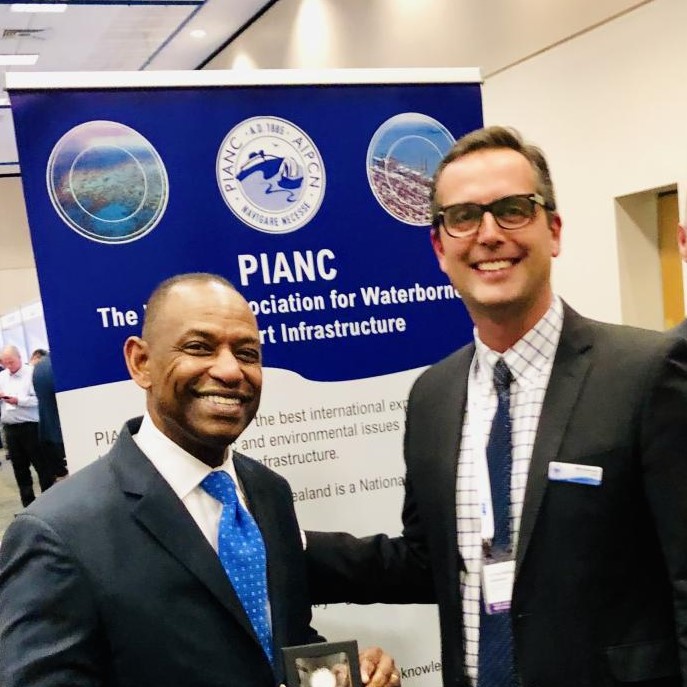PIANC’s Hobart Seminar – Crisis Management and Natural Disaster Response
Congratulations to the Organising Committee for a great PIANC Pre Coasts & Ports seminar!
The purpose of the seminar was to improve preparedness for natural disaster and crisis events that can occur in ports and harbours, sharing knowledge and first-hand experiences from around the globe with the ultimate intent to protect the environment and the communities that are served by port and harbour infrastructure.
The Seminar attracted guests from around Australia, as well as New Zealand, Japan and the US.
Our distinguished guests from the United States Army Corps of Engineers (USACE) – Dr Todd Bridges, Senior Research Scientist at USACE & Chair of PIANC’s Environmental Commission and James Dalton, USACE’s Director of Civil Works gave excellent presentations, as did Dr Hiroyasu Kawai – Director, Marine Information and Tsunami Department, Port and Airport Research Institute (PARI) Japan, who spoke on the tsunami disaster and reconstruction in port and coastal areas due to the 2011 East Japan Earthquake.
The two-day seminar held on the 9 & 10 September was designed for increased engagement by attendees during and in between presentations, resulting in more interesting discussions and deliberations, adding value to both speakers and attendees.
PIANC A&NZ Chair Will Glamore thanked the Organising Committee, Chris Carboon – Chair, A/Prof Ron Cox – Technical Program Coordinator, and the indefatigable Neil Lawson – Seminar Support, for all their hard work. “The Seminar had provided in-depth meaningful conversation” he said, “between global experts on critical topics of great relevance to the PIANC member community.”
Journalists from the DCN covered the event and reported on several presentations, including the following:
Jared Pettersson (Enviser Ltd) spoke about the recovery of the Port of Lyttleton following the 2011 earthquake, while Baird Australia Director David Taylor described some of the challenges surrounding cyclones affecting the North West shelf.
Defence, climate and security adviser and former Australian Army Colonel Ian Cumming gave a lively presentation about climate change and implications for ports and the boards of private companies.
Director of eCoast, NZ, Jose Borrero spoke about tsunami experiences and future mitigation, drawing upon several examples from the South Pacific. Dr Borrero pointed out that it wasn’t necessarily the size of the wave which caused most negative impact, but the strength of the currents. The difficulty is that currents are not easily modelled using any tsunami or long wave modelling. Borrero called for ‘robust numerical modelling to understand the range of possible tsunami effects.’
Managing Director of the Fremantle Maritime Simulation Centre, Capt. Rory Main, called for more safety training to avert accidents. Rules are not enough. ‘Most ports have a lot of rules’ he said, ‘what we need is an increase in skills.’ Main praised the Australian Maritime Safety Authority (AMSA) for its very high standard of regulation and safety but noted that the maritime industry worldwide needed a ‘paradigm shift’ in its thinking. Many ‘impose safety only because they’re told to.’
Other speakers included Kevin Kane, Senior Manager, Environment and Planning, North Queensland Bulk Ports who presented on cyclone and flood impacts on North Queensland Ports, and Anna Flower, Manager Security, Emergency Management & Business Continuity, TasPorts, who focused on the implementation of crisis and emergency risk management.
Susie Kropman, Director of the Marine Biosecurity Unit in the Australian Government Department of Agriculture and Water Resources spoke about Australia’s marine biosecurity risks and management, while Marcus John of Thomas Miller Australasia gave timely information on insurance implications for ports and natural disasters.
Jamie Storrie, Manager, Crisis Preparedness and Response, Australian Maritime Safety Authority (AMSA), looked at the management of complex maritime emergencies while Roger Kirk, Deputy Harbour Master, Port Operations Manager, Port Kembla spoke from his own experience: The Iron Chieftain fire in Port Kembla in 2018.
Tom Bishton, Senior Structural Engineer at BECA (NZ) presented on seismic impacts on port infrastructure while Dr Ben Popovich, National Institute for Water and Atmospheric Research (NIWA), NZ, looked at potential tsunami impacts on New Zealand port structures.
